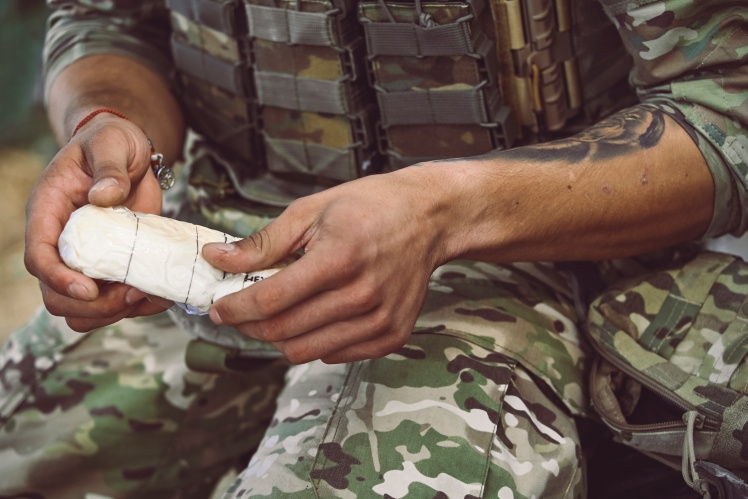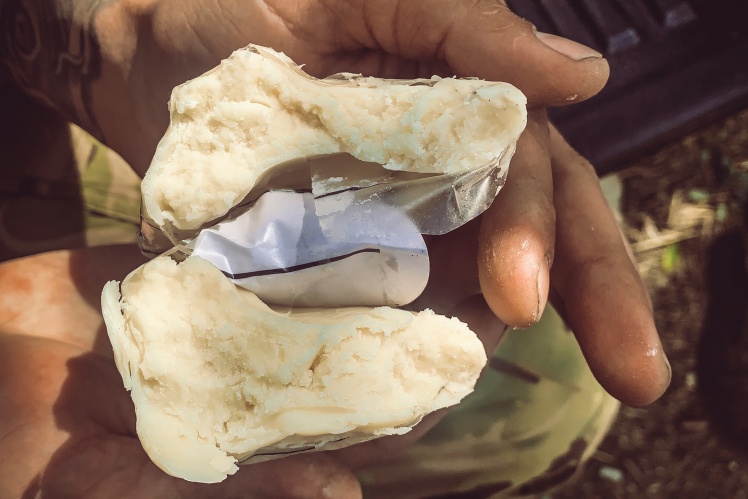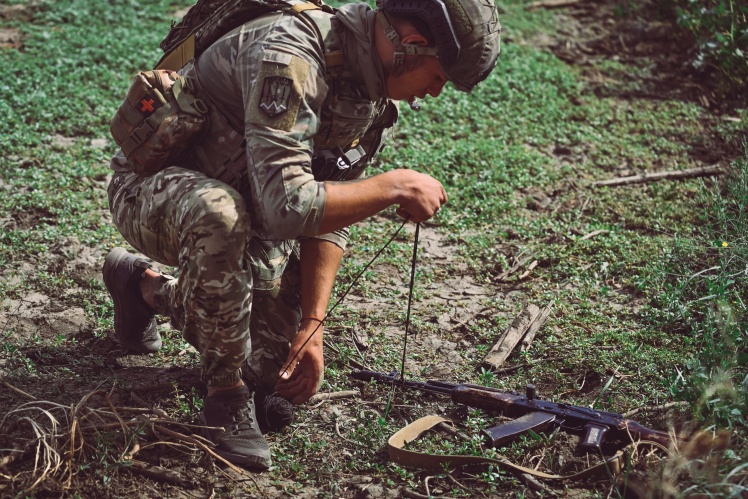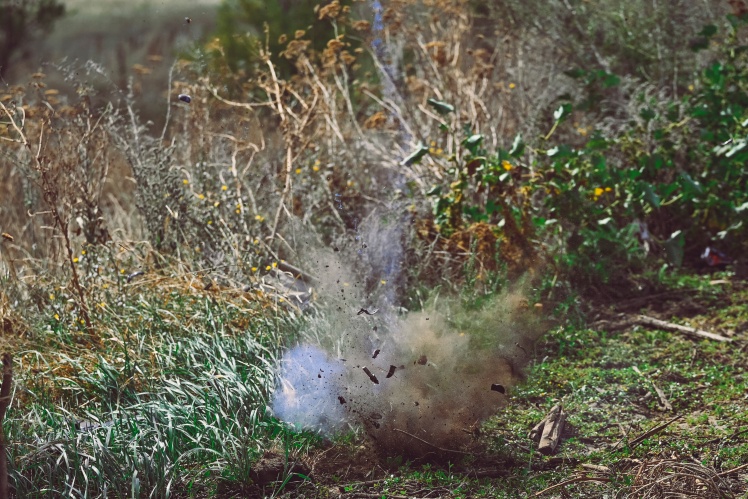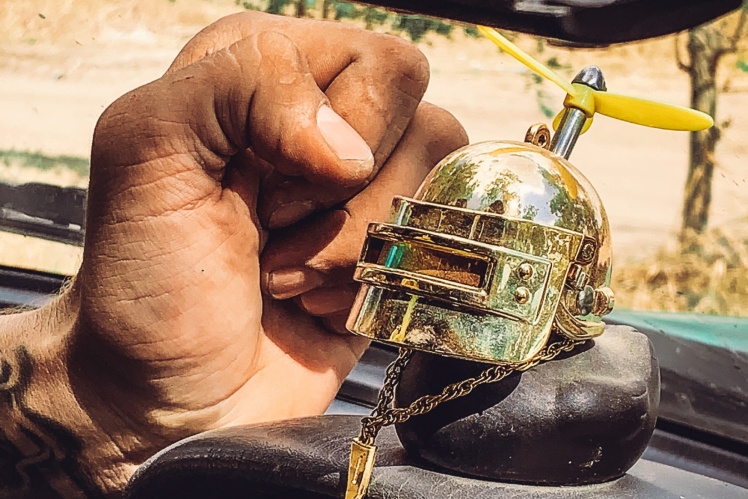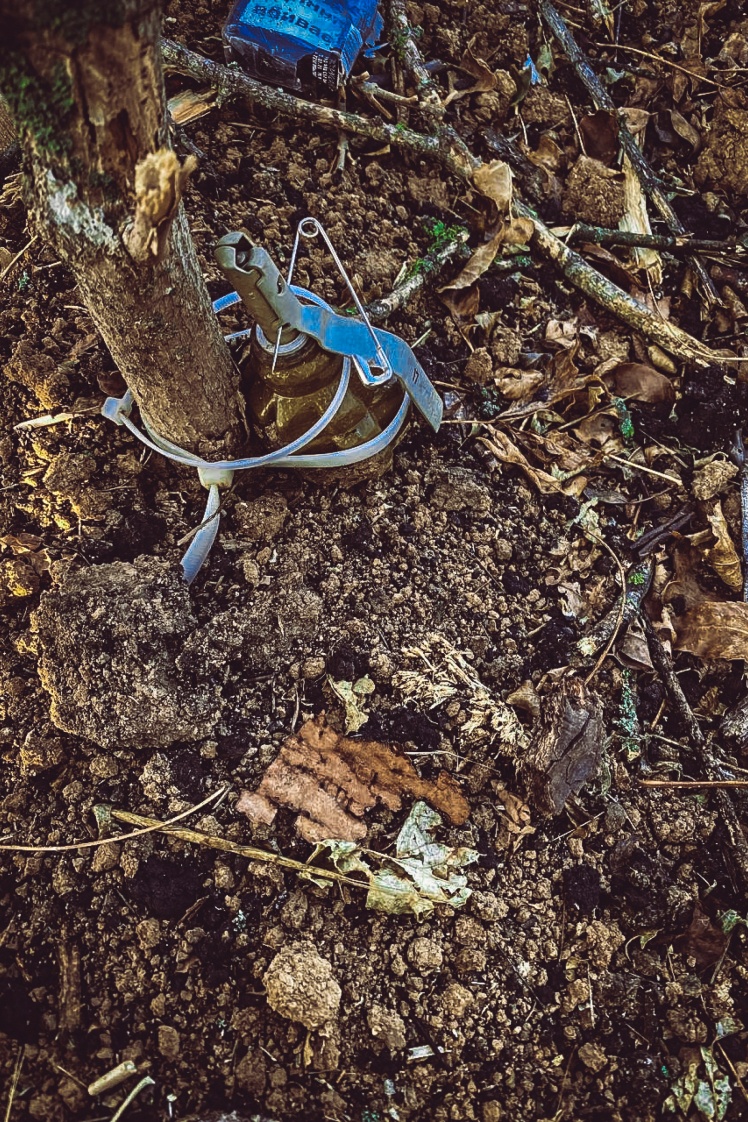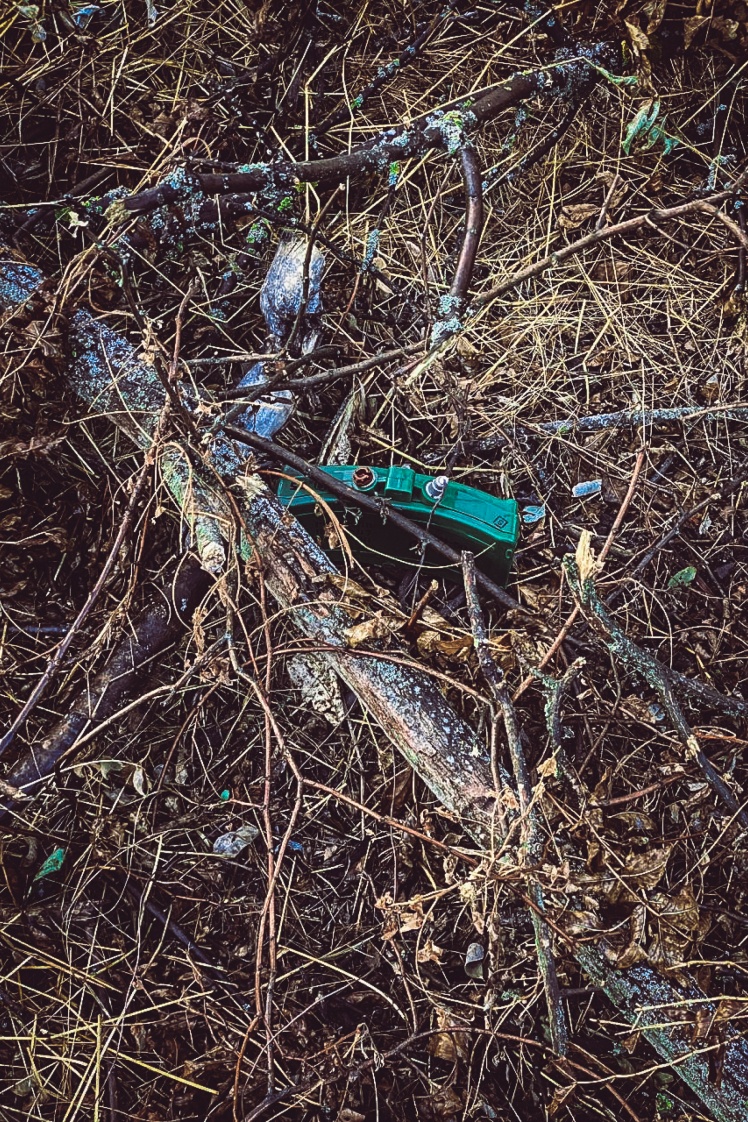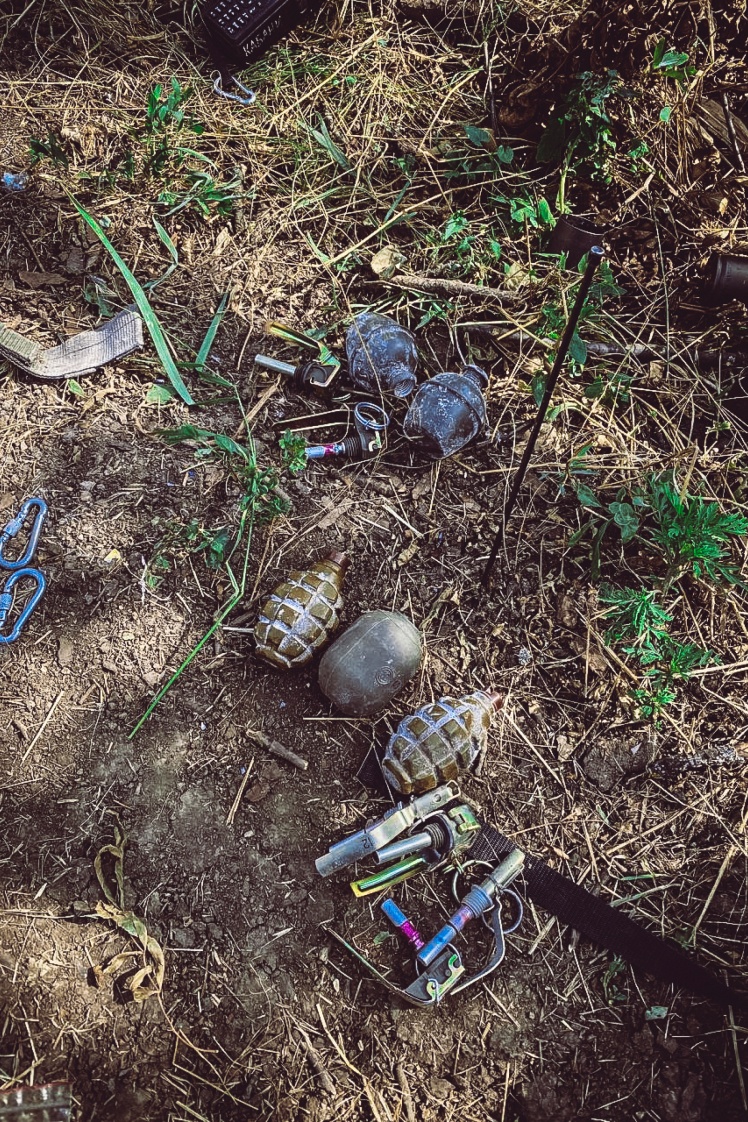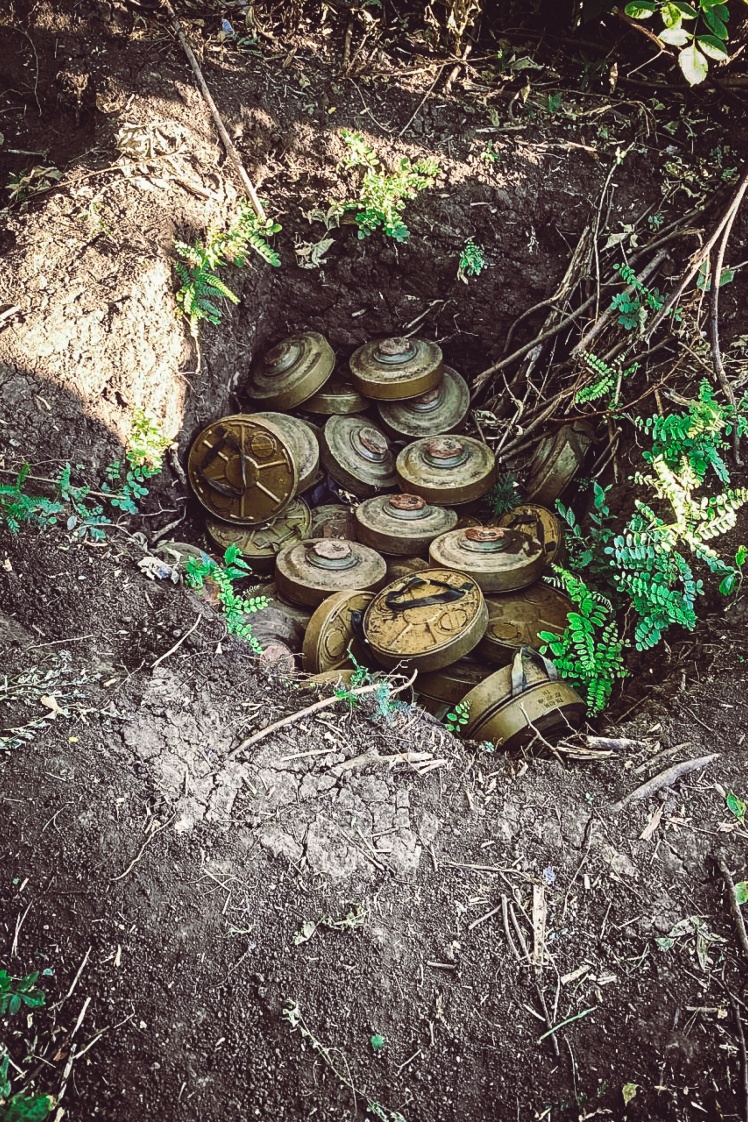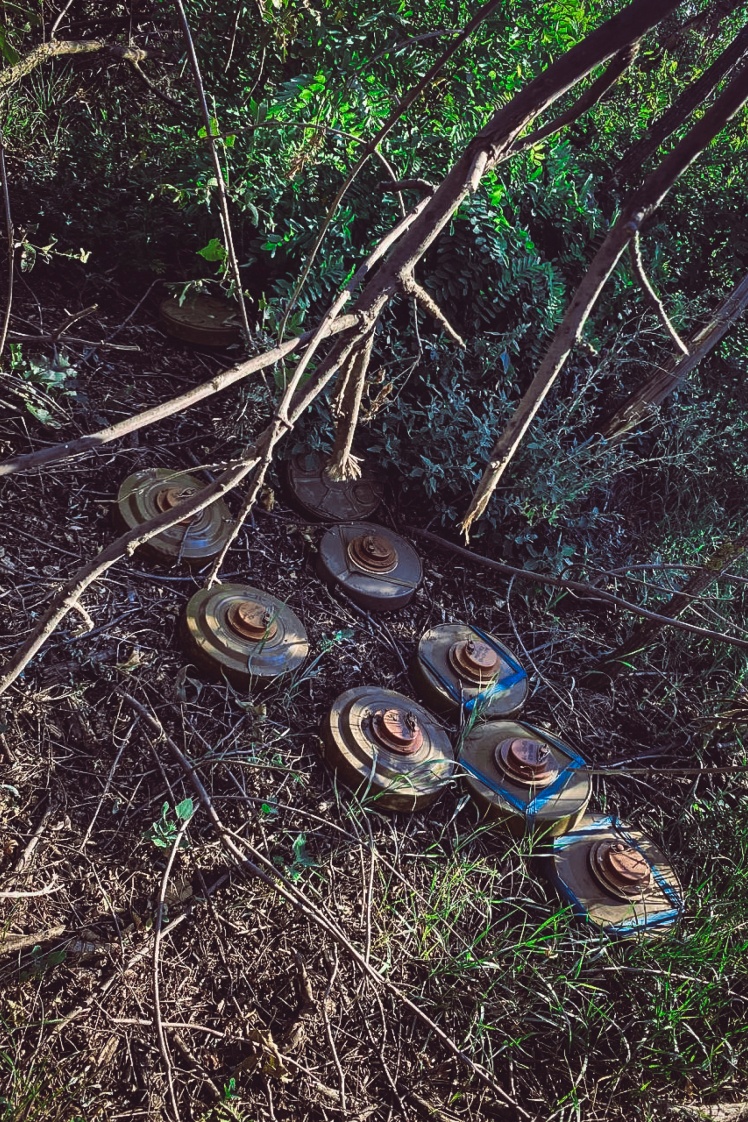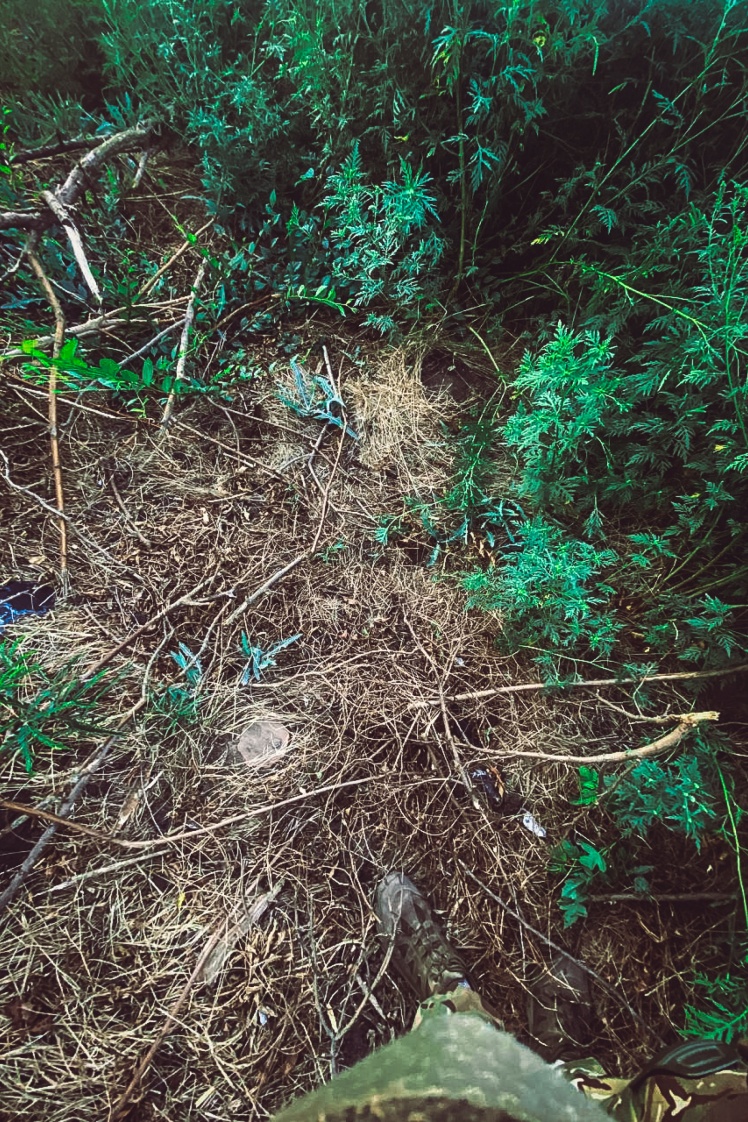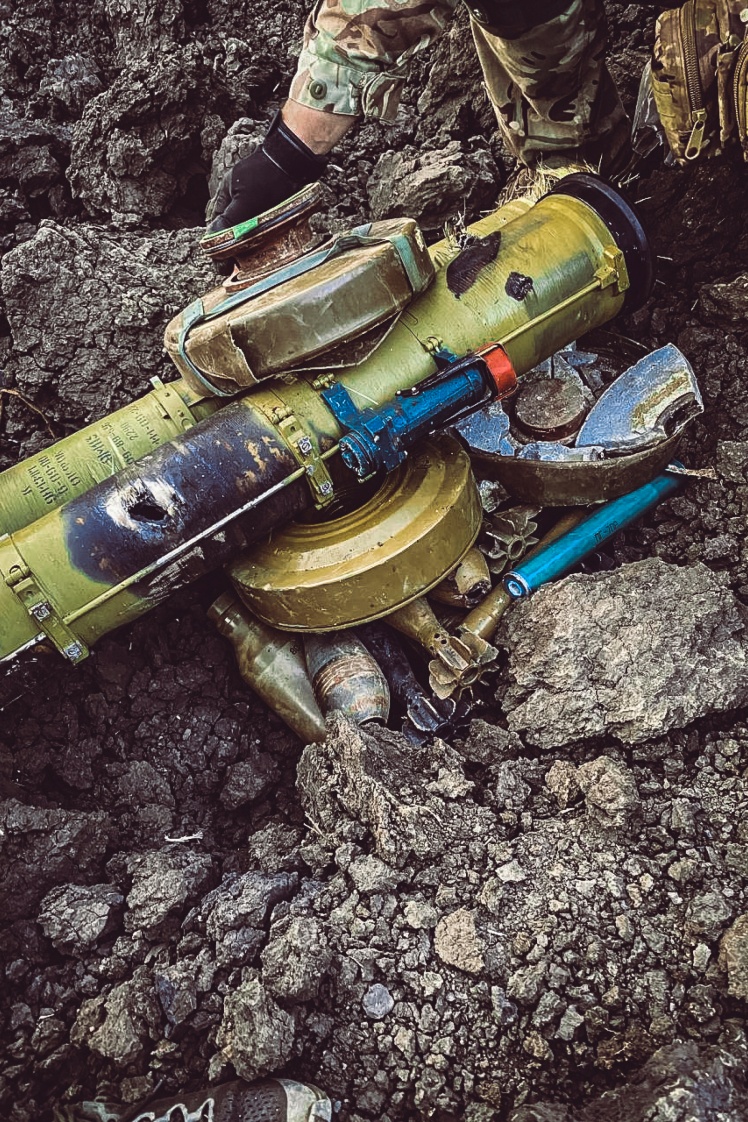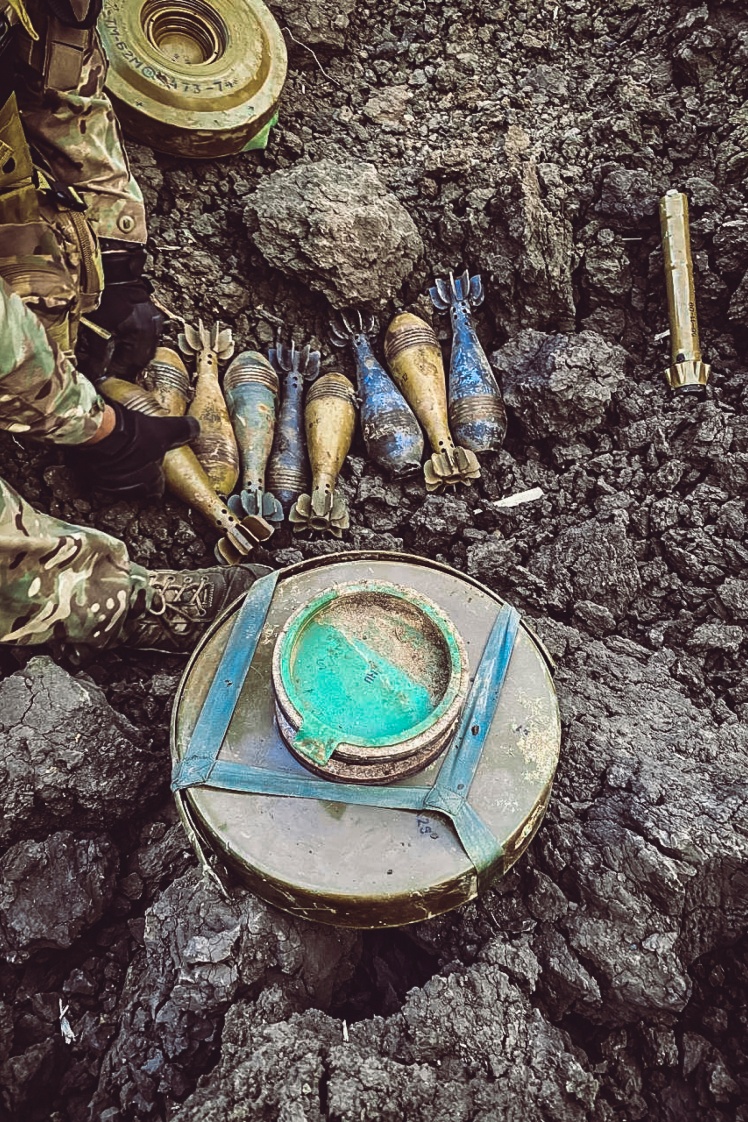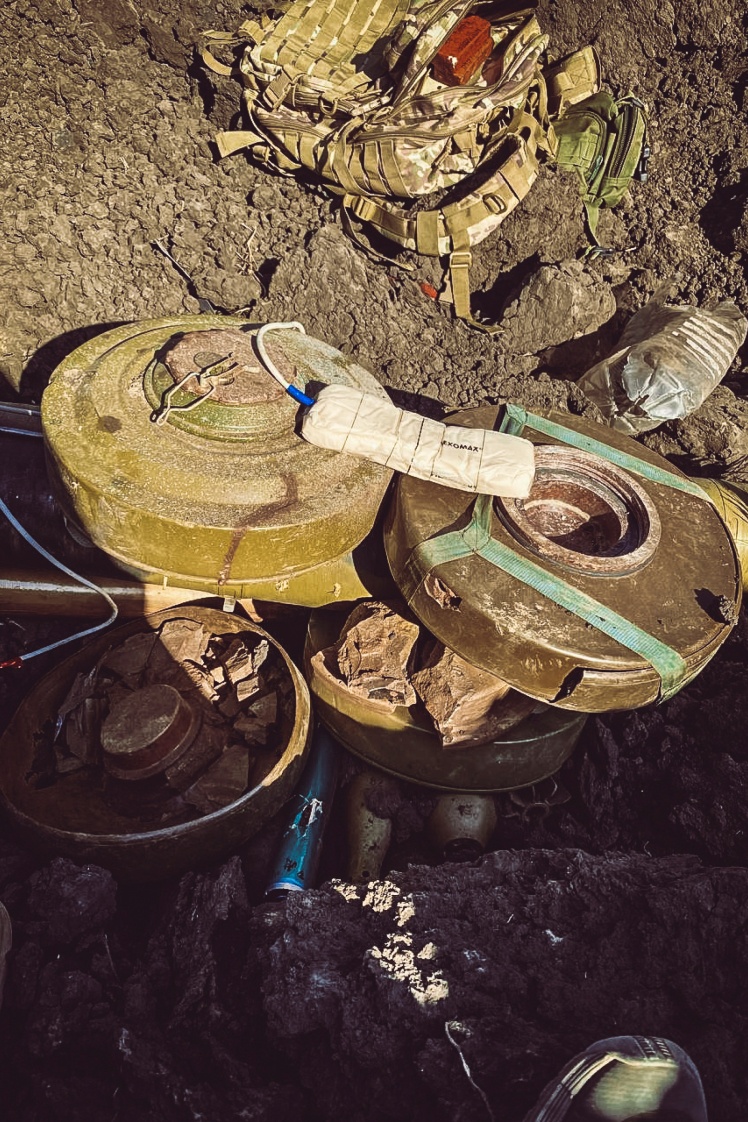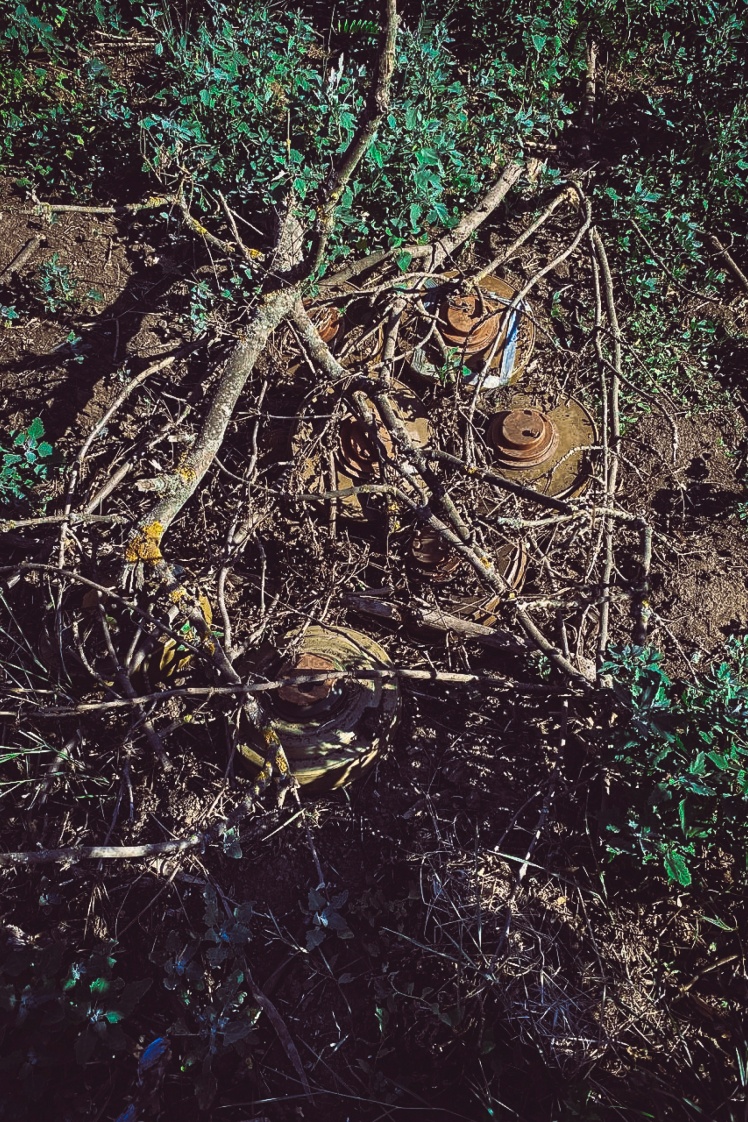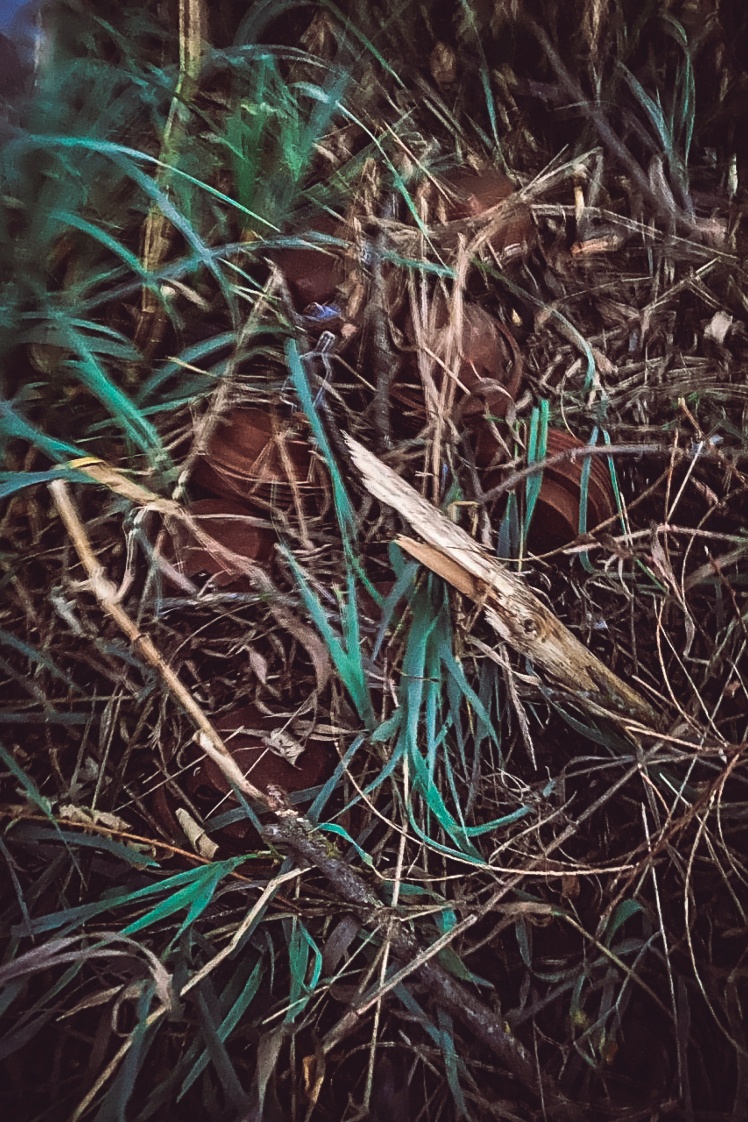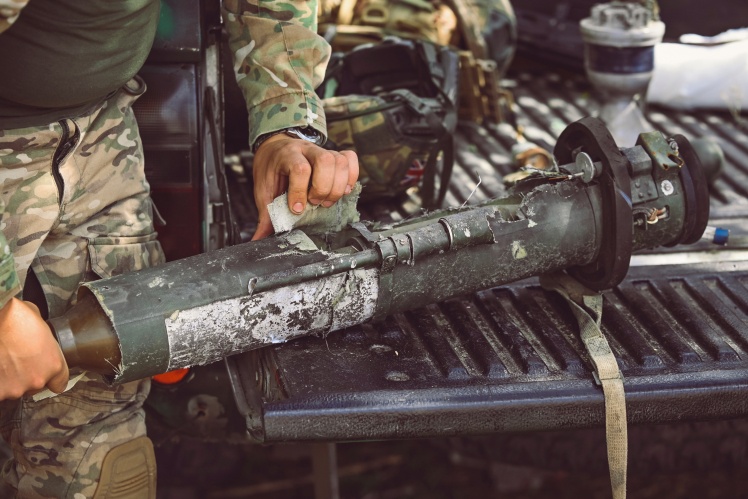Valerii and Danyil are almost the same age — Danyil is 23 years old, Valerii is 21. At the beginning of the Great War, the boys were conscripts in the same company, mobilized together. They joke among themselves that the military service saved them from the occupation.
Danyilʼs family lives near Kupyansk in the Kharkiv region, and Valeriiʼs family lives near Skadovsk in the Kherson region. Their villages were occupied in the first days of the invasion. Valeriiʼs relatives are still under occupation. His cousin died when she stepped on a mine, so for Valerii, the sapper case is "family history."
Danyil went to the mines because he "is good at gathering things that explode." Although he prefers demining rather than undermining territories, but Valerii is the opposite in this case.
Danyil became a sapper because he is good at gathering explosives. Valerii shows the remains of Russian mines and missiles.
Олексій Ковальов / «Бабель»
The boys studied as sappers for a month and a half, in the summer of 2022 they were sent to the south. The brigade in the "Offensive Guard" where they serve is called "Kara-Dag" after a mountain in Crimea. It was this brigade that stopped the advance of Russian troops between Robotyne and Orikhiv in February 2022, and now launched a counteroffensive.
Boys often work in pairs. During the year of service, they became experienced sappers, and they are assigned to train young people.
"A sapper learns all his life. The theory was told us by the ʼtextbooksʼ, and sometimes by the Soviet ones," says Danyil. "There are very few sappers, because the work is specific, abd there are often dead and wounded."
Valerii and Danyil together with their commander Oleksandr.
Олексій Ковальов / «Бабель»
As the boys say, most often sappers have their limbs torn off: feet, hands, fingers. The eardrums also burst.
"Debris arriving is not necessarily mines. During the explosion, a branch or a stone may fly," says Danyil.
One of his comrades lost an eye because a branch stuck in him. Another of his comrades lost half a foot when he went around a mine — he stepped on explosives that were lying nearby.
"It is not because he is careless, but because it is very hard to work. You constantly look at the grass, your eyes get tired," says Danyil. "Sappers have many accidents due to tiredness."
As Valerii told us, after the first explosion, sappers have a tradition: you have to eat a piece of TNT or plastid.
Sappers are part of assault brigades and work under fire.
Олексій Ковальов / «Бабель»
Valerii holds a piece of plastid. According to tradition, after his first explosion, he ate a piece of explosives.
Олексій Ковальов / «Бабель»
Valerii and Danyil clear the area so that infantry and military equipment can pass through it. The boys move forward in sync with the attack aircraft. First, a narrow path is made for foot soldiers — no more than 40 centimeters — then they turn around and widen it to two meters for equipment.
"The war goes from landing to landing. Stormtroopers ask: ʼMake way for the enemy landing.ʼ When we finish, we must follow clearly along the path. It happened that we laid the way, people was walked through it for two months, and a step away from the edge lay a mine," says Danyil.
Stretching on a grenade.
Олексій Ковальов / «Бабель»
The Russians constantly place mines on street signs, although this is prohibited by international humanitarian law. It is almost impossible to see a fishing line in the forest — only the morning dew that collects on it helps us. Russian trenches in forest plantations are also difficult to demine. Explosives are difficult to see in grass, especially when the eyes are tired. The guys pay attention to the withered grass — it is very likely that there is a mine, and the plant was pulled out by the root and put it on top.
"There are stretch marks everywhere in the enemyʼs trenches," Valerii says. "There is a mountain of garbage, and try to guess what exactly is mined there."
Valerii grabbed the thrown enemy weapon with a rope to pull from a safe distance. There may be explosives under it.
Олексій Ковальов / «Бабель»
The guys have a military duck in the car. When she was leaving the mine clearance, she was taken away by a raised object. When on a combat mission — in armor.
Ganna Mamonova / "Babel"
The Russians hide explosives in clothes and bottles, mine the dead bodies, place weapons on trip wires and place mine-traps under them. Most often, the Soviet ML-8 and ML-7 are also used. Any object is placed on the mine — a weight of 300 grams is enough — and pull the striker lever. You move an object and then an explosion occurs.
"You canʼt touch anything with your hands on the positions of the Russians. If you want to win a trophy, you need to throw a rope on it and pull it from a safe distance," says Valerii.
Plastic and hand-made explosives used by the Russians are not recognized by a metal detector. There are also mines with a "surprise" — when one explosive lies under another — they are also called "sandwich". Russians approach mining "creatively", because they have been taught this for years, they have sapper departments, say Ukrainian sappers.
Valery shows the principle of action of the mine "with a surprise" — there is a grenade under the anti-tank mine. The mine is not visible at all in the yellow grass.
Олексій Ковальов / «Бабель»
Sappers do not count how many square meters they demined during a year of service. They say that the more the front advanced, the more work was done. 300 square kilometers were freed in the Zaporizhzhia region. It is about 180 kilometers near Orikhiv and Vasylivka together with Robotyne, where Valerii and Danyil are fighting. Now the Armed Forces are approaching the village of Verbove. This is still about 10 square kilometers.
"The Russians held the defense here for more than a year, and all this time they mined. When we went on the counterattack, it was difficult to pass. Mine infestation greatly slows down the movement of troops, says Oleksandr Teplyi, the commander of Valerii and Danyil. Together with them, he also clears the territory.
Mines and ammunition that sappers find on Russian positions.
Даниїл та Валерій / «Бабель»
The guys work at night — from three oʼclock in the morning until dawn. The Russian defense line, known as the "Surovikin Line", consists of fortified fire lines, anti-tank ditches, "dragonʼs teeth" (these are concrete pyramids dug into the ground) and minefields. They are covered by artillery and snipers.
"You have to climb far. The Russians have good night vision devices. Sometimes they are better than ours," says Valerii.
Sometimes the Russians shoot on schedule. They start at eight in the morning and continue until noon. Then there is a break and again shelling. Sometimes one part of the road is shelled for half a day, and then — another part.
"We are conforming to it. The shelling is such that at six in the morning we have nothing to do," says Valerii. "We have to run away, but we canʼt, because we have to finish the job."
Parts of the missile with which the Russians will bombard the Zaporizhzhia region.
Олексій Ковальов / «Бабель»
Due to shelling, sappers cannot work for more than three hours in a row. There are sections that they pass quickly, and sometimes it is not possible to clear even 50 meters in a day.
"At three oʼclock in the morning, we climbed into position, and a sniper started working on us. We hid, sat in ambush for five hours. If you show your head, they will shoot you. Then we gathered ourselves, crawled on belly for 30 meters. Found a MON-50 grenade. Took it off. Then crawled back into the trench. I was so tired — it was hot, I was crawling in the mud, it was uncomfortable to work on your belly," recalls Valerii. "And then a reconnaissance group came and said that they had orders to shoot. They fired and left, and the artillery was deployed against us. The work is over."
"Once we were asked to break a way to the Russian dugout. Stormtroopers occupied the enemyʼs landing. Valerii only turned his ass towards the Russian positions, and the sniper started working on him. We already have a joke that if the Russians are hunting for the sappersʼ heads, then in the case of Valerii — for his ass," Danyil jokes.
Sappers pierce every 80 centimeters of the ground — they are looking for explosives.
Олексій Ковальов / «Бабель»
The equipment of the sappers are following: 50 meters of rope, a bulletproof vest, a helmet, a metal detector, a sapperʼs shovel, a machine gun and two types of rodes. One of them does not pass electric current, because there are mines that explode due to a short circuit. First, sappers conduct reconnaissance — they look for explosives with their eyes. Then they poke the ground with rodes, looking for buried mines. They work on the belly or knees. If the mine can be defused without exploding, it is disassembled and given to the military. Other mines are detonated in place. To do this, sappers dig a trench, throw a rope over a mine and pull it.
This is how Danyil checks every time with a rode whether there are explosives hidden in the garbage.
Ganna Mamonova / "Babel"
"If they donʼt shoot at us, then one day we can conduct reconnaissance, and the next — we can clear mines," says Valerii. "The speed of demining depends on many factors: shelling, the number of mines and the skill of sappers."
Sappers work at night. It is impossible to see the mines under your feet, but they do it.
Ganna Mamonova / "Babel"
"But speed in demining is a hindrance," adds Teplyi. "The slower, the better."
Sappers detonate the mine from a safe distance.
Ganna Mamonova / "Babel"
Valeriiʼs card for help: 5375 4112 0950 3817 and a link to the bank.



